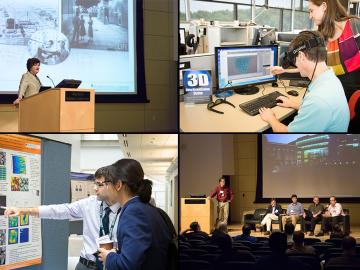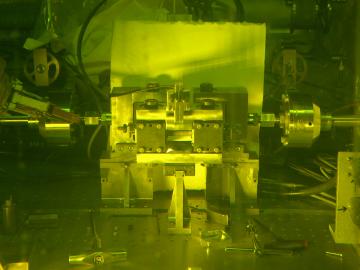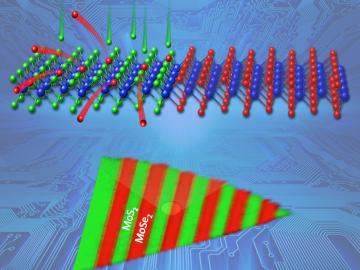
Filter News
Area of Research
- (-) Materials (340)
- Advanced Manufacturing (18)
- Biological Systems (15)
- Biology and Environment (143)
- Biology and Soft Matter (5)
- Building Technologies (5)
- Chemical and Engineering Materials (3)
- Chemistry and Physics at Interfaces (11)
- Clean Energy (354)
- Climate and Environmental Systems (9)
- Computational Biology (5)
- Computational Chemistry (5)
- Computational Engineering (3)
- Computer Science (7)
- Data (1)
- Earth Sciences (1)
- Electricity and Smart Grid (1)
- Energy Frontier Research Centers (14)
- Energy Sciences (2)
- Fossil Energy (2)
- Fuel Cycle Science and Technology (3)
- Functional Materials for Energy (14)
- Fusion and Fission (50)
- Fusion Energy (9)
- Geographic Information Science and Technology (3)
- Isotope Development and Production (2)
- Isotopes (30)
- Materials Characterization (2)
- Materials for Computing (26)
- Materials Synthesis from Atoms to Systems (13)
- Materials Under Extremes (12)
- National Security (70)
- Neutron Data Analysis and Visualization (2)
- Neutron Science (151)
- Nuclear Science and Technology (53)
- Nuclear Systems Modeling, Simulation and Validation (1)
- Nuclear Systems Technology (1)
- Quantum Condensed Matter (4)
- Quantum information Science (5)
- Reactor Technology (1)
- Renewable Energy (2)
- Sensors and Controls (3)
- Supercomputing (262)
- Transportation Systems (9)
News Type
News Topics
- 3-D Printing/Advanced Manufacturing (17)
- Advanced Reactors (2)
- Artificial Intelligence (8)
- Big Data (2)
- Bioenergy (10)
- Biology (4)
- Biomedical (5)
- Buildings (3)
- Chemical Sciences (28)
- Clean Water (2)
- Climate Change (5)
- Composites (5)
- Computer Science (16)
- Coronavirus (3)
- Critical Materials (8)
- Cybersecurity (4)
- Decarbonization (5)
- Energy Storage (26)
- Environment (13)
- Exascale Computing (2)
- Frontier (2)
- Fusion (5)
- Grid (4)
- High-Performance Computing (3)
- Isotopes (11)
- ITER (1)
- Machine Learning (4)
- Materials (58)
- Materials Science (57)
- Mathematics (1)
- Microscopy (20)
- Molten Salt (2)
- Nanotechnology (31)
- National Security (3)
- Net Zero (1)
- Neutron Science (28)
- Nuclear Energy (12)
- Partnerships (11)
- Physics (27)
- Polymers (11)
- Quantum Computing (2)
- Quantum Science (10)
- Renewable Energy (1)
- Security (2)
- Space Exploration (1)
- Summit (2)
- Sustainable Energy (9)
- Transformational Challenge Reactor (3)
- Transportation (8)
Media Contacts

In the Stone, Bronze and Iron Ages, the state of the art of materials science defined technology’s zenith and accelerated economies. Now, in the Information Age, data is beginning to drive the development of advanced materials, from photovoltaics for solar energy and superconductors for efficient el...

A new technology developed by the U.S. Department of Energy’s Critical Materials Institute that aids in the recycling, recovery and extraction of rare earth minerals has been licensed to U.S. Rare Earths, Inc.




It took marine sponges millions of years to perfect their spike-like structures, but research mimicking these formations may soon alter how industrial coatings and 3-D printed objects are produced.


From the bluebird painting propped against her office wall and the deer she mentions seeing outside her office window, Linda Lewis might be mistaken for a wildlife biologist at first glance. But rather than trailing animal tracks, Lewis, a researcher at the Department of Energy’s Oak Ridge National Laboratory, is more interested in marks left behind by humans.

With more than 30 patents, James Klett is no stranger to success, but perhaps the Oak Ridge National Laboratory researcher’s most noteworthy achievement didn’t start out so hot – or so it seemed at the time.

Less than 1 percent of Earth’s water is drinkable. Removing salt and other minerals from our biggest available source of water—seawater—may help satisfy a growing global population thirsty for fresh water for drinking, farming, transportation, heating, cooling and industry. But desalination is an energy-intensive process, which concerns those wanting to expand its application.


